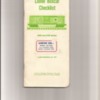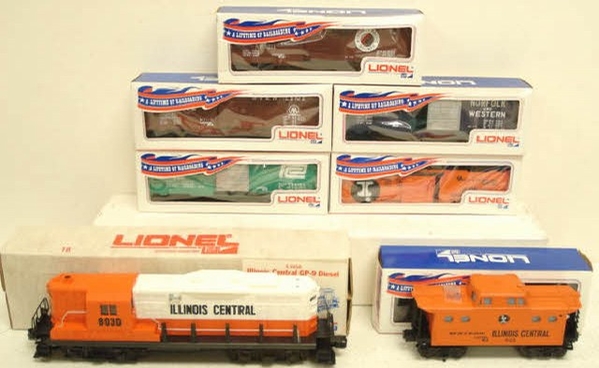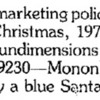I am one of the very few collectors of Modern Lionel from 1970 to present that likes variations. What is a variation? It is something that was made, stopped and remade again and looks the same until one starts looking closely at the product. The reason why Modern Lionel has so many variations in the first ten years of production is the changes that the company made from metal to plastic. Also, some parts were missing and new ones had to be fabricated. As time marches on, Lionel continues to improve on there product until they make State of the Art Modern Electric Trains--Today.
References to finding information are posted in the next paragraphs and check out the email address I have put further in this writing. That email address brings to you a very plethora of information and pictures about variations in Post-War and Modern Day Lionel Trains.
References to Lionel Variations are as follows***
***Classic Toy Trains Magazine NOVEMBER 2014 -- The fascination of Lionel's "transition" freight cars of the early 1970s Pages 60 thru 63 with script and pictures.
***LCCA Lion Roars Magazine, DECEMBER 2016 Part 1 of 3 Glenn Zibart, "Looking Back at the MPC 9200 Series Boxcars" ***LCCA Lion Roars Magazine, OCTOBER 2017 Part 2 of 3 Glenn Zibart , Looking Back at the MPC 9200 Series Boxcars" ***LCCA Lion Roars Magazine, DECEMBER 2017 Part 3 of 3 Glenn Zibart, Looking Back at the MPC 9200 series Boxcars" Mr Zibart articles are fascinating and very educational.
***Greenberg's Lionel Train Price Guides--hard to find--Magazine Format somewhere in the early 1980s. A very comprehensive study of both Post War Lionel and Modern Lionel Trains including many variations. The guides were based on Bill Eddins vast collection of Postwar and Modern Lionel Trains. Unfortunately, Mr. Edddins passed on in 1979. [The above Greenberg's Price Guides are NOT A REPAIR MANUAL, they are price guides with many many pictures of variations especially The Modern Era -- I seem to have misplaced my Price Guides and will hunt them up -- sincerely yours railbear601]
I will concentrate on the 9200 series boxcars. The first 9200 series cars that hit the market were made from Post War 6464 boxcars series molds. Hence the cars came with blank end plates, metal door guides, some have rows of rivets but many of the cars had them removed for easier decoration. The metal floor of the cars have a round "bubble" and two holes in them. They were painted shinny black or dull black (many of the dull black floors are bare metal showing rust). The bubble floor was a carry over from the post-war operating boxcar and Lionel would punch out this bubble to put a plunger in this area to operate the car. As the years moved on, the bubble floor turned to flat black floors with 2 holes, and finally flat black floor with 6464 stamped into them. Many cars that came in the 1970s have Post-War Trucks brought over from the Hillside NJ Lionel Post War Plant to Mt. Clemens Michigan. The first truck change was to take the 1955 roller bearing truck and mold it into a slippery plastic truck. The wheel sets were metal axles with "fast angle" wheels. The wheels were thick with four knobs on the inside. The coupler armature was made from stiff plastic (memory plastic?) that did not work well. The metal in the armature was a square piece of steel that was attracted to the magnetic track coil. This square piece of metal usually shows some rust. The brake wheel was changed to plastic that shows breaks in it sometime. The wheel was attached by shoving it into a hole in the boxcars and many cars come with missing brake wheels. And some of the boxcar doors had a piece of "scotch tape" on them to keep them from opening up --the only thing this tape did was to make a sticky mess on the outside of the boxcar and it was difficult to remove without marring the paint on the car!!
So what happened to change the cars. Most of the first production run of the cars came as pointed out above. In 1971, the Post War Timken Truck mold gave out and Lionel adopted a new truck called the Symmington Gould. It had a thicker truck side frame and roller bearing design. These newly designed trucks came with "better" memory plastic and were on all Lionel "better" cars. The Gould trucks lasted til Richard Kughn brought out a newly designed plastic roller bearing truck which is used on most beginner train set cars -- even today. This truck was on all Lionel Cars including bay-window cabooses until the new Legacy Era came when Lionel went back to using sprung 2 or 3 spring metal Timken trucks with roller bearing caps or Bettendorf trucks. (One note about Baywindow caboose trucks--the plastic Symmington truck was changed over to the Post-War Metal Type when Lionel brought out the Northern Pacific Service Station Set in the late 70's. The Green & Yellow Baywindow Cabose in the Northern Pacific Set was the first entry of this postwar revamped metal truck). Lionel had developed a sprung truck back in 1973 to put on there new Standard "O" Cars. At first, the standard O trucks came with plastic coupler armatures and Lionel improved the truck with metal coupler armatures. The Legacy-Vision line metal trucks are used on all Lionel Premium "O" Scale Cars today. Lionel's new premium Legacy-Vision Line cars are top of the line. Kughns roller bearing plastic trucks are still used on Lionel introductory level freight cars and are excellent runners.
When the Timken Truck Mold gave out in 1971, Lionel made the Symmington Gould truck. They had problems with the large side frames fouling quad hopper car ladders and the steps on the early steam loco tenders. Lionel quickly decided to shave part of the Mountain Tender and Square Tender Rear steps to prevent the Gould truck fouling. This lasted until 1975 when Lionel changed the Metal Truck Bolster on the quad hopper to a smaller ladder plastic bolster that just snapped in place in the quad hopper car.
Back to our 9200 Boxcars. The revamped coupler armature into the late 1970 and early 1971 had a square piece of metal that was changed to a flat round tack that was black in color. Some of the cars came with shinny flat round tacks. Eventually Lionel used an enlarged shinny thumbtack that is still used today on the Kughn era plastic roller bearing trucks.
As time marched on, Lionel started to improve the truck design and the first premium steam engines before Legacy came with a metal 2 or 3 axle wheel designed tender truck and some of the tender trucks had problems with the wheel sets falling out of the 3 axle design because there was a plastic insert inside that truck that would not hold the wheel sets in. Lionel got to work and fixed the problem very soon. I think the problematic tender trucks were on these Locos -- Box #18001 Loco #5100 4-8-4 Rock Island Steam Loco & Lionel Box #18003 Loco #1501 4-8-4 DL&W Steam Loco. Also these Engines had a problem with there Motors. (I sent both Locos back to Lionel to have there Motors Fixed because of a bushing and bearing problem--they were fixed correctly). And finally, the Rock Island Engine was die-cast in Hong Kong or Taiwan and had slight bubbles in the top of the loco casting. I did not have that problem fixed. They were a handsome engine which was a "Northern Type" on a Berkshire Body but it had problems.
The 9200 Boxcars started changing in 1971 by having there metal door guides changed to plastic door guides. (These door guides are out of production and care must be used when pushing a boxcar back into it's box because one can easily snap off these plastic door guides and there are no replacements.) One other note: When Lionel ran out of the plastic door guides, they started using metal door guides again and the last door guide was a single plastic door guide in 1972. This is the reason why so many of the 9200 cars come with so many different door guides in the first 3 years of production. The 9200 IC Boxcar and the 9230 Monon Boxcar are examples of these various door guides. (There are many more 9200 boxcars that show these various doorguides).
The Gould Truck started replacing the Timken Trucks in 1971. So some 9200 cars have Post War "style" Timken trucks and some have the Gould Trucks. And in late 1972, Lionel discontinued the double metal door guides and plastic to single plastic door guide on the top of the car and a molded in rail on the bottom of the car known as the 9700 mold. Many of the 1971 9200 boxcars have 9200 series imprinted on one end of the car body. When the single plastic door guide cars came out, usually 9700 imprint was stamped on one end of the boxcar. Some collectors say they have 9700 single plastic door guide cars that have 9200 imprinted on one end of the boxcar. All of my 9200 cars with single plastic door guides say 9700 on the end plate. -- As shown in Ed H pictures of Lionel variations, by Frank Kloss: http://www.lioneltoytrainvariations.com/ There is a #9705 D&RGW that has 9200 imprinted on the end of the boxcar -- (to me this car is very rare). You would think that all cars made in 1970 would have double metal door guides and no imprint on the end plate of the car. You would think that all cars built in 1971 would have 9200 imprinted on the end plate of the car and most likely have Symmington Gould Trucks and all cars built in 1972 would have single plastic door guides with 9700 imprinted on the one end of the car....The answer to that question is Not Necessarily So. Lionel built 15 -- 9200 series boxcars and then stopped with car #9215. Then they started up and made one last car #9230 Monon. 9200 Illinois Central built in 1970 was also built again in 1971 and again in 1972--but the date on the outside of the car says built in 1970. Besides that, the IC 9200 Boxcar comes with double plastic door guides and even single plastic door guides. Also the boxes changed from the red, white, blue banner MPC Box to the Red and White Fundimensions MPC Box. and if you were lucky enough to catch a 9200 IC Boxcar in a plain white box with #9200 stamped on one end of the box, that was really unique. Why did this happen? Just as Lionel builds trains in the Legacy-Vision Era called BTO (Built to Order), the 9200 series boxcars were BOD cars. (Built on Demand). Who knows how many of the first run of the 9200 IC Boxcars were made...but after the first run, Lionel had a lot of demand for this Colorful Orange Boxcar and remade them. So in late 1970 or early 1971 Lionel remade the IC Boxcar and it came with the 9200 imprint on one end of the car and metal door guides and now it gets strange, Lionel put double plastic door guides on the car and when they ran out of plastic door guides, they put metal door guides back on the car again. Hence it is very difficult to tell what year some of the 9200 boxcars were made. Also, the boxes were changed along with the printing on them. The only thing that I know is the 9200 series boxcars with blank car end imprints are the first ones to be made and the cars with the 9700 end imprint are the last ones made. Every car made in 1971 could come with plastic or metal door guides. And the boxes had there printing changed. Plus don't forget, the trucks on these cars changed too. The 9200 boxcars are an example of the variations produced by Lionel and don't forget all other cars in the Lionel Lineup were going through through this same process--such as the Quad Hoppers, Tank Cars, etc. I chose the 9200 series boxcars as they are still plentiful and can be obtained at decent prices.
Besides all of this, the wheels were changed to shinny wheels, some with knobs or no knobs on the inside of the wheel---and the space between the big IC on the outside of the car is thin or wide. And if you think this is strange, some of the boxes have tags on them with rubber stamp 9200 IC Boxcar in red or black. Then you have a box with a tag on it and the 9200 IC Boxcar printed on a press neatly in black print. And then you have some boxes rubber stamped with red or black or blue color. Several of the boxes were rubber stamped upside down. The IC 9200 boxcar has more variations than any of the other ones in this series. As far as rarity goes, I would say that the car with the blank-end imprint commands a little bit more in price. Also, the single plastic door guide car is a little rarer than the rest of them. Please review Mr. Zibart's Articles in the 3 Lions Roar Magazines I mentioned...He has done a magnificent job. If you like what I wrote, maybe i shall write an article on all of the cars and the variations I have. The 9200 cars that were remade in the late 1972s with single plastic door guides command a little premium price and cars that I found that have single plastic door guides are 9200 IC (one of my single plastic door guide IC cars comes on a gray painted mold. You can see the gray paint when examining the inside of the car). 9209 Burlington Northern, some come in a single plastic door guide, 9214 Northern Pacific has some cars on single plastic door guides, and the Monon 9230 has some of the cars on a single plastic door guides. This writing might sound confusing, but to Lionel, they were putting out a product that the public wanted and quality control of painting, printing, boxes, etc was not the number one thing on their minds. Should you start to collect variations in the 9200 series MPC Boxcars? Well, there are still plenty of these cars out in circulation and the price is right. I am now 75 and most likely will put the cars on sale. You won't get rich collecting these variations but collecting these cars might give you some enjoyment. This is a bit of Lionel History that most likely will never be repeated.
If you think the above variations are strange, I have 2 sets of 12 Spirit of 76 boxcars that come with metal bolsters and another complete set that have plastic bolsters. These cars were built during the 1975's and went through the change from metal to plastic. They were both made 2 different ways because the demand for these cars were high and when they made a second run of the cars, the metal bolsters were gone and Lionel had changed the car mold which now had a round plastic pedestal for the truck to be attached to. It took me years to search out these cars to get these sets in order. Another strange coincidence is the GE U Boat Engine in this set has Atlantic Coast Line printed on some of the running board side frames and others do not have it...yes, I have one of each. The only thing that did not have variations (at least to my knowledge) is the Porthole Caboose. Did you know that Lionel made more Porthole Cabooses in this Modern Era than any other time? That Porthole caboose was used only on the Pennsylvania, Penn Central, and Conrail Railroads. The Porthole caboose was put in many sets in the Post War Era too and it read Lionel Lines and Pennsylvania.
Please scroll down and look at Ed H responses to me. And look at my responses to him. He has sent an email address for a gentleman that has many Modern Lionel Variations. (Fantastic) and he sent a second response to me about the "minting" of certain early Modern Lionel Cars and how many they made of them...I never knew this kind of "stuff" existed. Sincerely yours, railbear601
















